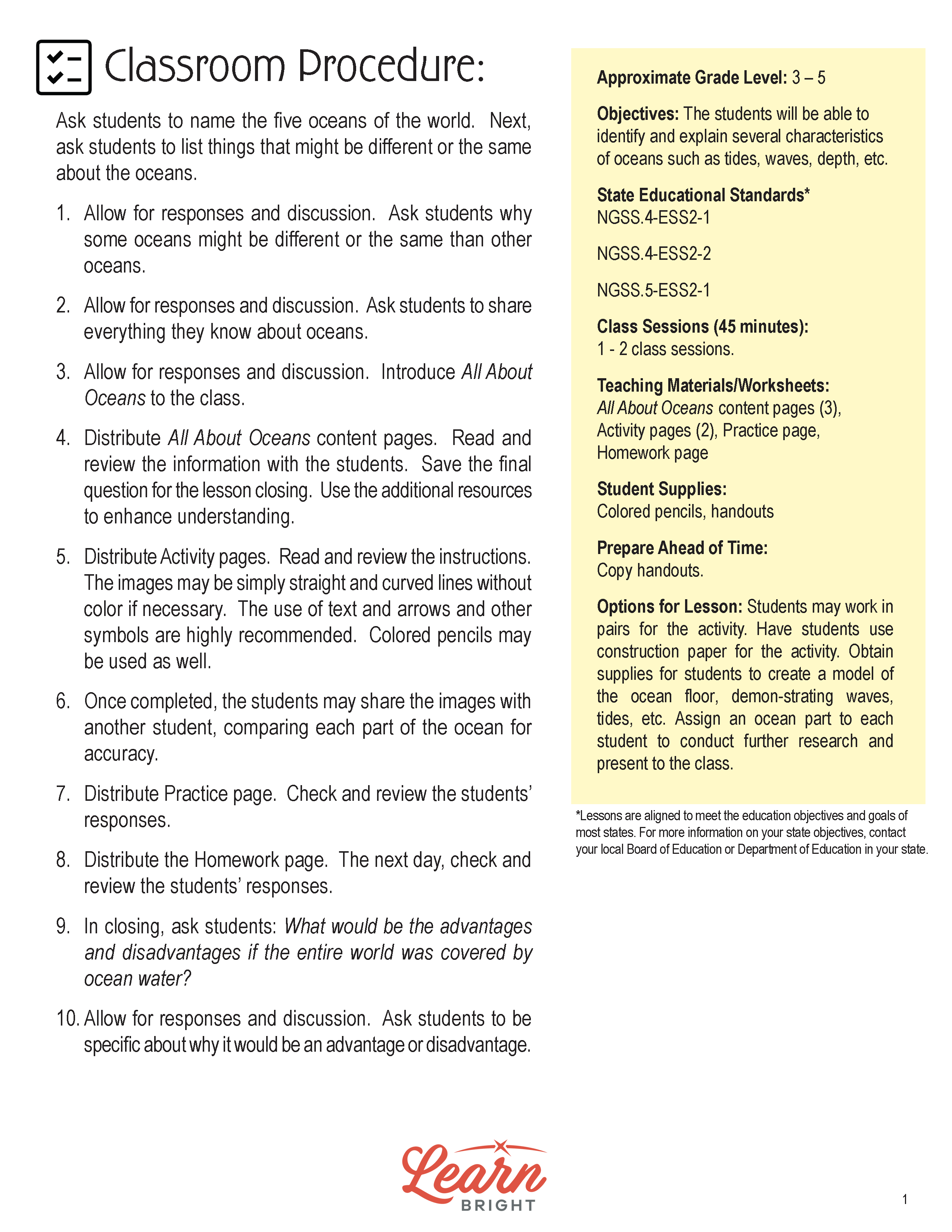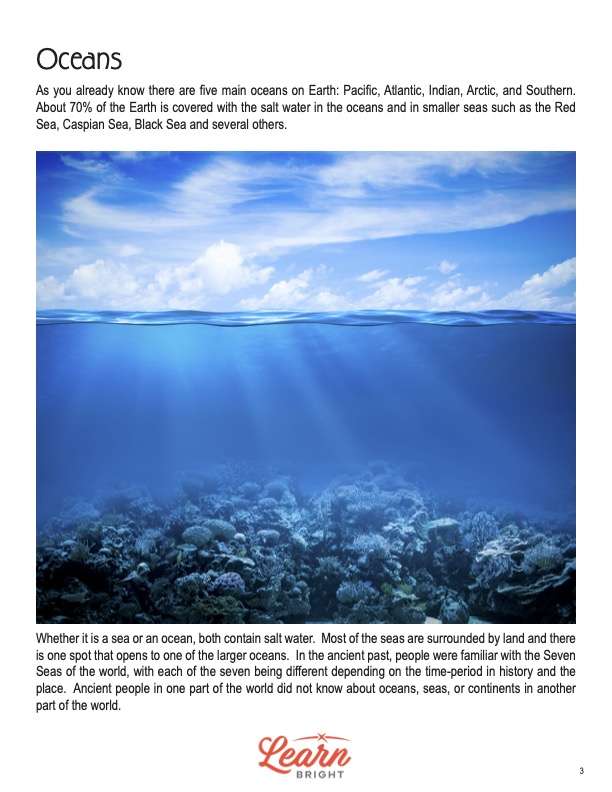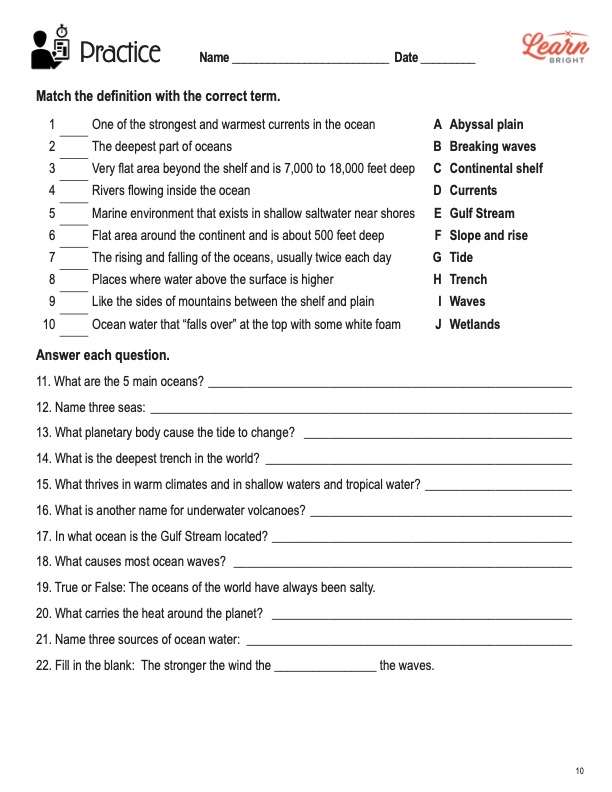Description
What our All about Oceans lesson plan includes
Lesson Objectives and Overview: All about Oceans teaches students some of the traits of these large bodies of water. Students will be able to identify and explain common ocean traits like tides, waves, and depth. This lesson is for students in 3rd grade, 4th grade, and 5th grade.
Classroom Procedure
Every lesson plan provides you with a classroom procedure page that outlines a step-by-step guide to follow. You do not have to follow the guide exactly. The guide helps you organize the lesson and details when to hand out worksheets. It also lists information in the yellow box that you might find useful. You will find the lesson objectives, state standards, and number of class sessions the lesson should take to complete in this area. In addition, it describes the supplies you will need as well as what and how you need to prepare beforehand.
Options for Lesson
There are several suggestions in the “Options for Lesson” section that you could incorporate into the lesson plan if you wish to add activities or tasks or have extra time. A few of these ideas relate specifically to the activity. Students can work in pairs for the activity rather than alone, for instance. You can also have them use construction paper instead of the worksheet page so that they can draw larger pictures. Another option is to obtain supplies for students to use to create models of the ocean floor or to demonstrate waves or tides. Another idea is to assign a part of the ocean to each students to research and later present to the class.
Teacher Notes
The paragraph on this page provides extra information or guidance about the lesson. It suggests using this lesson as an opportunity to help students better understand the characteristics of the different parts of the ocean. It also mentions that it might be a good idea to teach this lesson conjunction with other lessons about the ocean. You can use the lines on this page to write out last-minute thoughts before delivering the lesson to your class.
ALL ABOUT OCEANS LESSON PLAN CONTENT PAGES
Oceans
The All about Oceans lesson plan contains five content pages. Students first learn some basic facts about earth’s five main oceans: Pacific, Atlantic, Indian, Arctic, and Southern. Oceans, along with a number of seas, cover around 70% of the earth’s surface. Both seas and oceans contain salt water. Most of the seas are surrounded by land with only one spot that allows the water to reach one of the larger oceans.
In ancient times, people became very familiar with the Seven Seas of the world. Their understanding of each sea differed depending on where it was and the time period in history. People in one part of the world didn’t even know about oceans, seas, or continents in another part of the world. These bodies of water divide the seven continents, some by thousands of miles. Technically, one giant ocean covers the whole earth. The continents’ separation simply helps name different parts of it.
Although there are different oceans, nearly all of them have several common characteristics. For the most part, they all have waves, tides, and ocean floors. However, if the ocean is frozen, such as is the case in the Arctic or Southern Oceans, there are no waves. However, they still have an ocean floor and other common traits.
Characteristics of Oceans: Waves and Tides
Students will learn that all oceans have salt, a floor, coastlines, depth, and both living and non-living things within them. People use oceans for transportation, fishing, exploration, and as a natural resource. Five traits that oceans have in common are waves (except in frozen parts), tides, depth, floor, and salt.
Waves occur when the water moves in a certain way and rises above the level of the ocean’s surface. Wind pushes the water, which piles up to form a wave. The stronger the wind, the higher the wave, and these waves can travel for miles. Breaking waves fall over or collapse at the top. It is easy to spot these waves because of the white foam that forms at the top.
Ocean tides rise and fall, usually twice each day. The gravitational pull from the moon is responsible for creating these tides. The reason is that the moon’s gravity pulls the ocean water toward the side of the earth that’s facing the moon. At the same time, the rotation of the Earth causes water to move away from the side facing the moon. This yields what we call high tides and low tides, and the timing of these tides changes by about 50 minutes each day.
Depth, Floor, and Salt
The next element students will learn about is ocean depth. There are different parts of the ocean floor. The continental shelf is a flat area around a continent that is about 500 feet deep. The abyssal plain is a very flat area beyond the shelf that is anywhere between 7,000 and 18,000 feet deep. The abyssal plain covers about 40% of the ocean floor.
The continental slope and rise are like the sides of mountains between the shelf and the plain. Trenches are the deepest parts of the ocean. The Pacific Ocean has the most trenches of all the oceans. The Mariana Trench is the deepest trench in the world at 36,163 feet deep. Volcanic and earthquake activity takes place around these trenches.
The bottom of the ocean is the called the ocean floor, which is usually rocky or sandy in the parts that are close to land. Coral reefs cover parts of the ocean floor as well. These regions thrive in warm climates and shallow, tropical waters. Unlike the beautiful and bright coral reefs, the abyssal plain is covered with sediment, and only a few plants live in the muddy, dark, high-pressure environment. There are also underwater volcanoes on the ocean floor that discharge scalding water.
Students will then discover that the oceans had no salt billions of years ago. Water came into the ocean by rain, rivers, and streams, as well as by groundwater. As the water flows across the land, it collects minerals from rocks. In addition, volcanoes that erupt in the ocean release other chemicals, resulting in the presence of sodium and chlorine, which makes salt. Ocean water is actually 96.5% pure and only 2.9% salt. The rest is a mixture of other chemicals and minerals.
Climate and Currents
The lesson explains that oceans help keep the earth’s climate habitable. These giant bodies of water help keep many places from getting too hot or too cold. As an analogy, the ocean is like a bathtub full of hot water. Comparing a bathtub of hot water to a small cup of hot water, the bathtub would stay warmer for longer. Currents are what help carry the heat around the planet.
Currents are rivers that flow inside the ocean in approximately the same location year after year. The water from different locations eventually mixes together as currents flow. Warm tropical waters move north or south to heat up the cold water in the polar regions and vice versa, keeping the ocean in balance.
One of the largest, strongest, and warmest currents is the Gulf Stream. The Gulf Stream begins off the coast of Mexico in the Gulf of Mexico and flows around the southern United States. It passes below Florida and continues up the east coast. Then it crosses the Atlantic Ocean and circles around the west coast of Europe and Africa. The gulf is about 43 miles wide and 1,500 feet deep, and it travels about 100 miles per day. In fact, the Gulf Stream current actually influences the weather throughout the whole world.
ALL ABOUT OCEANS LESSON PLAN WORKSHEETS
The All about Oceans lesson plan includes three worksheets: an activity worksheet, a practice worksheet, and a homework assignment. Each one will help solidify students’ comprehension of the lesson content. You can refer to the guidelines on the classroom procedure page to determine when to hand out each worksheet.
DRAW THE FIVE TRAITS ACTIVITY
The activity worksheet has five empty boxes across two pages. Students will draw a picture that depicts five different ocean parts: waves, tides, depth, floor, and salt. They can use information from the content pages to help them remember the properties of these different parts. They will need to use arrows and symbols or labels to help viewers understand which ocean part the picture depicts. Students can work with partners or groups instead of by themselves if you prefer.
MATCH AND ANSWER PRACTICE WORKSHEET
For the practice worksheet, students will first read 10 definitions. Using the words in the word bank, they will match the terms to the correct definition. Then, they will answer 12 questions using the facts they learned during the lesson.
ALL ABOUT OCEANS HOMEWORK ASSIGNMENT
The homework assignment requires students to review 15 numbers that relate to the lesson. Students will explain how each number is significant as it applies to oceans. Then they will read five sentences and fill in the blanks with the right ocean part.
Worksheet Answer Keys
The final two pages of the lesson plan document are answer keys for the practice and homework worksheets. These answer keys provide the correct answers in red. Students’ responses should match those of the answer keys for the most part. The first section of the homework assignment may yield slightly different responses from students. However, their answers should reflect the answer key even if worded a little differently. If you choose to administer the lesson pages to your students via PDF, you will need to save a new file that omits these pages. Otherwise, you can simply print out the applicable pages and keep these as reference for yourself when grading assignments.










